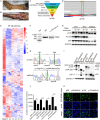Case Report: A Novel Mutation in NFKB1 Associated With Pyoderma Gangrenosum
- PMID: 34447408
- PMCID: PMC8383449
- DOI: 10.3389/fgene.2021.673453
Case Report: A Novel Mutation in NFKB1 Associated With Pyoderma Gangrenosum
Abstract
Pyoderma gangrenosum (PG) is a rare, destructive inflammatory skin disease of which a painful nodule or pustule breaks down to form a progressively enlarging ulcer. Ulcerations associated with PG may occur after trauma or injury to the skin. The etiology has not been clearly elucidated. Our report described a PG patient with a heterozygous splice-donor-site mutation in NFKB1 (c.730+5G>A) causing the absence of exon 8 and the formation of truncated p105 (p.Asp191_Lys244delinsGlu; p105delEx8), which led to distinct symptoms of high fever and excessive inflammation in wound area after routine surgical procedures. The functional analysis showed that the variant caused reduced phosphorylation of p105 and resulted in the decreased processing of p105 to p50. We conclude that the patient's symptoms were caused by dysregulation of the NF-κB signaling pathway.
Keywords: NF-κB signaling pathway; NFKB1; inflammation; novel mutation; pyoderma gangrenosum.
Copyright © 2021 Fang, Wang, Jiang, Wang, Cheng and Zhou.
Conflict of interest statement
The authors declare that the research was conducted in the absence of any commercial or financial relationships that could be construed as a potential conflict of interest.
Figures

References
Publication types
LinkOut - more resources
Full Text Sources
Research Materials
Miscellaneous

